The Ptolemaic period began with the conquering of Egypt by Alexander the Great in 332 BCE. Egypt would then be governed by Ptolemy I, a trusted Macedonian lieutenant and companion of Alexander until 302 BCE, when Ptolemy I would establish himself as pharaoh of Egypt, granting himself the title Ptolemy I Soter (“The Savior”). The Ptolemaic dynasty would be the last pharaonic dynasty of the Egyptian kingdom and would last until 30 BCE, when it would end with the death of Cleopatra VI and the conquering of Egypt by the Romans. Ptolemaic Egypt represented a unique blend of cultures. Macedonian Greeks integrated themselves into Egyptian society and simultaneously Hellenized the Egyptian kingdom. The pharaoh was replaced by the Ptolemies, the Greek language replaced the Egyptian language in the upper echelons and administration of Egyptian society, and Greek soldiers inhabiting Egypt brought their own culture and religion, inevitably influencing Egyptian society. As a result, Ptolemaic Egypt has brought about a rich trove of sources, allowing historians to understand both Ancient Greece and Ancient Egypt in new ways. Most excitingly, Ptolemaic Egypt provides an opportunity to consider how identity formed and expressed itself in ancient cultures, particularly with the interaction between two inherently different cultures: the Greeks and the Egyptians. This blending and evolution of identity presented itself in many forms in Ptolemaic Egypt. Literary texts are valuable, showing the Hellenization of Egyptian literature and the striking blends between the two. Artistic representation provides another medium of identity expression, showing how Egyptian values and Greek values integrated themselves and to what degree. However, one particularly illuminating form of identity expression comes from the coins that the Ptolemies minted throughout their time in ancient Egypt.
Coins: More than a Monetary Unit
Coins were a valuable multipurpose tool introduced to the Egyptians upon their conquest by the Macedonian Greeks. Not only did they serve a practical purpose, allowing for payment of goods and services, but they also served as a valuable propaganda tool. Before Greek occupation, the Egyptians relied on a trade good bartering system and didn’t have a coin-based economy. Ptolemy introduced standard coinage to the Egyptians, restructuring their economy and inherently making it more Greek-like. The coins also served to make the ruling class, or more specifically, Ptolemy I, richer, granting them valuable metals, rather than the agricultural and trade goods that the Egyptian pharaohs of the past would have counted as wealth. Additionally, the coins served as a valuable propaganda tool, cementing the rule of Ptolemy I under the leadership of Alexander the Great (Worthington, 1996). No other physical object would be in wider circulation or seen by a wider range of people. Thus, the images imprinted on the coins were carefully thought out and held a lot of meaning even through their somewhat simple depictions. By following the coins minted over the centuries in Ptolemaic Egypt, one can see how the Greeks slowly incorporated an increasingly Egyptian ideology into their culture. The first coins circulated in Egypt were minted in Memphis under the governorship of Ptolemy I, years before Alexander the Great had passed, and decades before Ptolemy I had declared himself as pharaoh. As such, these coins were minted to represent Alexander the Great in a solely Greek fashion.

These coins feature excessively Greek attributes. The gold coin depicts the goddesses Athena and Nike on its sides while the silver coin depicts Herakles and Zeus. No depiction of Alexander himself is presented. Rather, the only attribution of these coins to Alexander are the inscriptions of his name on the reverse sides showing Nike and Zeus, respectively. Following the death of Alexander the Great, a new series of silver coins was minted under Ptolemy I, with minor changes to its iconography.
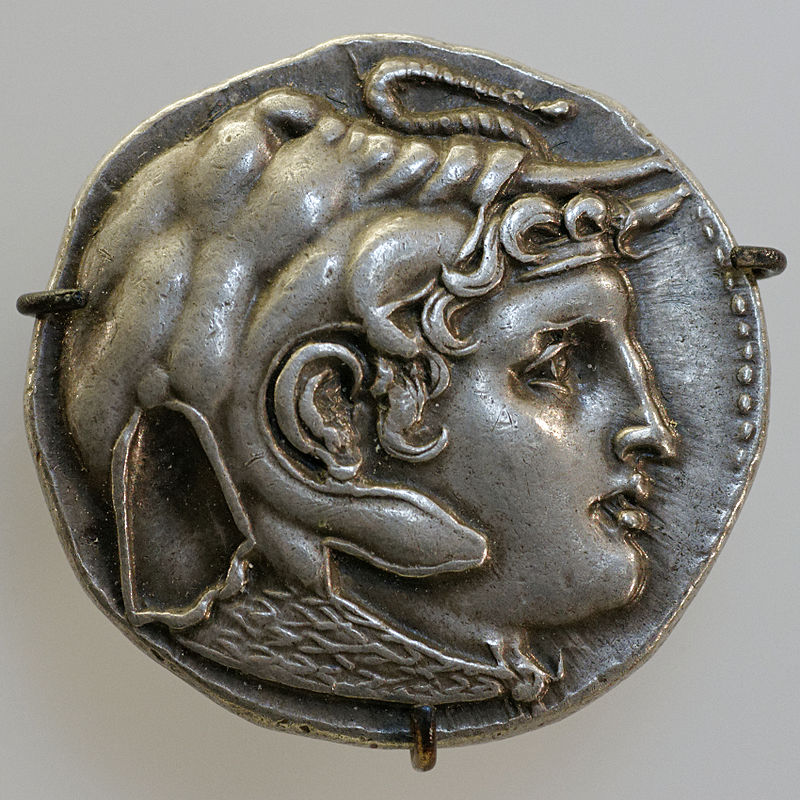
The first notable difference is that Alexander himself is now portrayed in similar fashion to Herakles. Instead of a lion pelt, Alexander is depicted as wearing an elephant scalp, perhaps referencing his conquering of Africa, India, or the general relevance of elephants to Alexander as a resource (Alexander used elephants in his army to help conquer Asia Minor) (Worthington, 1996). The back of the coin remains the same as the Herakles-Zeus coin seen above. Interestingly, by depicting Alexander on the coin in the same style as the Herakles-Zeus coin, Alexander himself is attributed as being divine and the son of Zeus. Ptolemy mints a coin honoring Alexander and grants him the highest honor any Greek can bestow, that of divinity (Worthington, 1996). Coins such as these continued to be minted and circulated throughout Egypt honoring Alexander for the next decade.
Ptolemaic Coins: Purely Greek? Or Something More?
The coins minted in Egypt before Ptolemy I were clearly all heavily influenced by Greek-style iconography. No Egyptian influence is seen in either the iconography or the ideology presented. Rather, we see a perfect example of traditional Greek coinage. Coins depicted gods and goddesses important to Greeks, while also honoring Alexander the Great. Only following Alexander’s death is he then depicted as a god. This is an important trend in Greek coinage. Living kings weren’t depicted as gods on coins. Notably, the idea of a god-king wasn’t a foreign concept to the Greeks; however, it still remained offensive to many Greek cultures and was actively avoided at the time of Alexander the Great (Worthington, 1996). It wouldn’t be until 304 BCE, when Ptolemy I would declare himself pharaoh, that the minted coins would change. A new series of coins would be distributed throughout Egypt, directly honoring Ptolemy himself.
Gold drachma and Silver drachma depicting Ptolemy I wearing a diadem on the front. On the reverse, an eagle is seen perched atop a lightning bolt. Both were minted around 304 BCE.
From these new series, we see a couple of interesting phenomena. First, Ptolemy is still clearly engaging with Greek iconography. In both the gold and silver series, Ptolemy is seen wearing a diadem, a Greek symbol of royalty. On the reverse side, an eagle is seen atop a lightning bolt, tying Ptolemy to Zeus. Interestingly, by depicting only the eagle, rather than Zeus and the eagle as seen in the coins honoring Alexander, Ptolemy is depicting himself to be further from divinity than Alexander. Second, Ptolemy’s desire to honor Alexander more than himself is apparent. Ptolemy obviously sought to honor himself with these coins but didn’t wish to honor himself more than he had honored Alexander the Great. Alexander was presented as a divinity post-mortem through Ptolemy’s minted coins. He was connected to the gods and was tied closely with major gods including Zeus, Athena, Herakles, and Nike. Yet in Ptolemy’s depiction of himself through his own coins, Ptolemy is only linked to the symbols of the gods and has aspects of divinity associated with him. By presenting himself in such a way, Ptolemy’s concern for his Greek audience is apparent. Ptolemy did not wish to diminish the legacy of Alexander the Great nor did he wish to anger the many Greeks who would have revered Alexander by overly representing himself as a god (Worthington, 1996). Notably this is in contrast to what would have been expected of the new pharaoh by the Egyptian people. In Egyptian culture, the pharaoh was a god walking amongst men, a literal god-king. Ptolemy I’s decision to only partially represent himself as divine in his coinage shows the active engagement he had with both the Greek and the Egyptian cultures. On the one hand, Ptolemy had to honor Alexander and not present himself as a god. On the other, Ptolemy as acting pharaoh was expected to be depicted as a god by the Egyptian people. This first series of minted Ptolemaic coins depicts the compromise between these two cultural expectations.
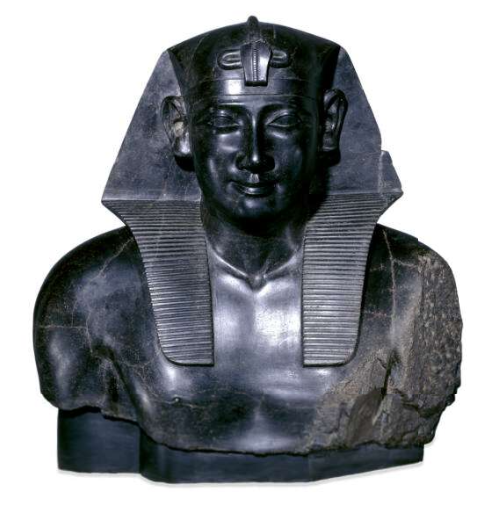
Interestingly, Ptolemy I was not afraid of presenting himself as a classic Egyptian pharaoh. In fact, in other reliefs and sculptures, Ptolemy is unrecognizable as a Macedonian Greek. Rather he is presented fully as an Egyptian pharaoh. A reason why Ptolemy portrayed himself as Macedonian Greek in his minted coinage is possibly due to the usual recipients of those coins. These minted coins would have been used to pay the Greek army and mercenaries. Native Egyptians would have been exposed to the coins, but every Greek would almost certainly be interacting with these coins. Perhaps Ptolemy represented himself as Greek in coins but Egyptian in sculptures because he knew that the Greeks would be exposed to the coins and would care less about his portrayal in Egyptian style sculptures. At the same time, the Egyptian people were used to Egyptian style sculptures but were not accustomed to standard coinage of any kind. Thus, it wasn’t terribly concerning for the Egyptians to see Greek styled coins depicting their pharaoh.
The Ptolemies: More Divine and Egyptian Than Ever
With the succession of every Ptolemy, their coins became increasingly Egyptian, with more ideology and iconography influencing the imagery present on the coin. However, the coins still remained dominantly Greek. At the same time, concerns with presenting the Ptolemies as divine faded over time, as future Ptolemies were distanced from Alexander the Great by time. These ideas become apparent through the coins minted by Ptolemy II and become increasingly so in later Ptolemaic coins.
On this series of coins, the same Greek iconography is seen. The figures themselves are still portrayed in a Greek manner and both the men and women have diadems asserting their royalty. However, more Egyptian ideology and mythology presents itself on this coin. Ptolemy II now presents both himself and his sister, who is also his wife on the front side of the coin. This brother-sister portrayal is directly from Egyptian myth. Gods and goddesses often married their siblings, with the most famous being Osiris and Isis. In order to present themselves as divine royalty, Ptolemy II sought to mimic the Egyptian pantheon presenting his own brother-sister relationship. On the back, Ptolemy I and his wife Bernice are presented with the label of “Gods”. Notably, this coin seems to be an exception to other coins produced by Ptolemy I-IV in regard to the explicit “Gods” label. Few other coins minted during the Ptolemy I-IV’s reigns ever directly label a Ptolemy as a God. Notably, not all coins portrayed this husband-wife duality. Take for example the bronze coins minted during Ptolemy II’s reign.
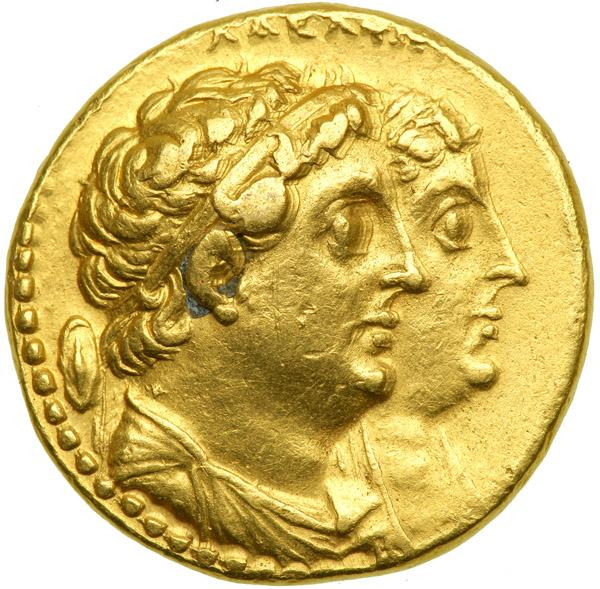
Gold drachma. The front depicts Ptolemy II and his sister-wife, Arsinoe both wearing diadems.
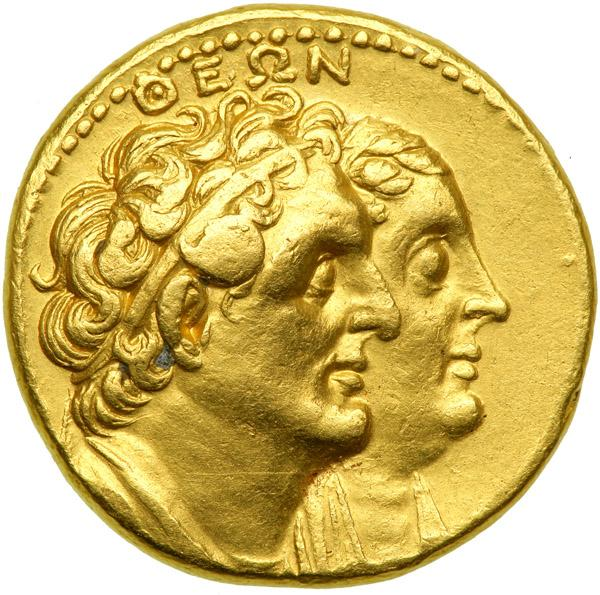
The back depicts Ptolemy I and his wife Bernice with an inscription meaning, “Gods”.
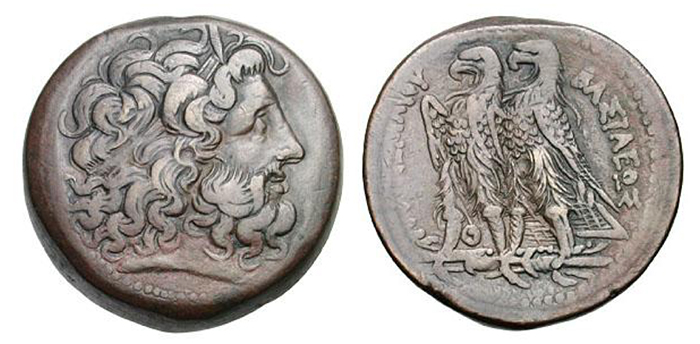
These coins depicted Zeus-Ammon, a blend of the Greek god Zeus and the Egyptian god Ammon. Zeus-Ammon is depicted in a dominantly Greek guise; however, he does have a couple Egyptian features. First, the horn present is a reference to the horns of the Egyptian sky god Ammon. Second, the eyes are depicted as wide and without pupils, once again signifying the divine character of Ptolemy I. This lack of pupils was characteristic of Egyptian divine iconography. The wider, beady eyes were thought to add more divine presence, reducing the amount of recognizable humanity (Worthington, 1996). Often pharaohs in Egyptian culture would be represented in art without pupils in their eyes. On the reverse of this bronze coin, a pair of eagles was presented. This pair of eagles most likely represented Ptolemy II and Arsinoe II, indirectly connecting them to divinity. Comparing Ptolemy I and Ptolemy II mintages, more Egyptian ideology is clearly present in Ptolemy II’s coins. Egyptian myth directly influenced the gold coin while Egyptian iconography was present on the bronze coin. Ptolemy II also appears to have lost the reservations his father held towards depicting Ptolemy as a god. In both the bronze and gold series, Ptolemy II has no issue presenting his father in a divine manner.

Ptolemy III’s coins present a blend of Ptolemy I and Ptolemy II’s coins. On the front, Zeus-Ammon is presented in the same fashion that Ptolemy II’s coins presented him. On the reverse, a single eagle is depicted, almost exactly in the same way as on Ptolemy I’s coins. The only major difference is the inclusion of the cornucopia, a symbol Ptolemy III adopted and commonly presented himself with. The cornucopia was meant to symbolize Ptolemy III’s nature as a benefactor to the people.
Bronze drachma: On the front, observe Zeus-Ammon. On the back, observe an eagle atop a lightning bolt
Ptolemy IV and on: From Greek to God
It wasn’t until Ptolemy IV that a major shift in coin imagery occurred. Ptolemy IV minted a coin honoring Ptolemy III that completely abandoned precedent. In this coin, Ptolemy III is depicted with more divine symbols than ever seen on any other Ptolemaic mintage. Specifically, Ptolemy is presented with the radiate crown of Helios, the trident of Poseidon, and the aegis of Zeus. Notably, some scholars believe that the trident actually portrays a three-forked winged scepter, associated with Ammon more than Poseidon. Regardless of which interpretation is taken, Ptolemy is presenting himself as a combination of divine gods, emphasizing his divine like features. The crown was thought to represent his brilliance, the scepter his control over the seas, and the aegis his strength. Overall, relatively little Egyptian ideology is seen. In fact, only the eyes without pupils are a representation of Egyptian ideology. Every other symbol present is of Greek nature. Notably, on the reverse of the coin, the inscription only dictates Ptolemy as a king, rather than as a god. Ptolemy IV’s era shows how the Ptolemies became less concerned with their depiction as a god. However, they still made it a point to clearly label themselves as a king and only heavily imply their divinity through imagery. This is once again most likely due to the mixture of audiences for these coins. The Egyptians still expected their pharaoh to be a god while the Ptolemies still didn’t want to overrepresent themselves and risk alienating some of their subjects.
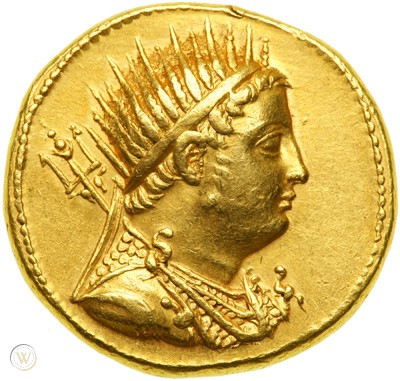
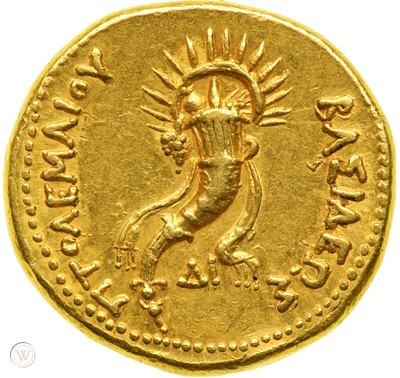
Gold drachma presenting Ptolemy III wearing the crown of Helios, the trident of Poseidon, and the aegis of Zeus. The back presents a cornucopia, the symbol Ptolemy III adopted during his reign.
Ptolemaic Coins: An Evolution of Greco-Egyptian Identity

The bronze coin minted during both the reign of Ptolemy V and VI once again incorporated more Egyptian ideology. Specifically, it depicted Isis, one of the most important goddesses in Egyptian mythology. On the reverse, an eagle riding a lightning bolt is still depicted. A massive shift in iconography makes itself present. The coin is essentially now 50% Greek and 50% Egyptian, showing how much influence Egypt has had upon the Ptolemies and the Greeks by extension. Egyptian influence was so great that it made itself a significant part of later Ptolemaic coinage. Notably, Isis coins were but a subset of the coins continually produced by the Ptolemies. In fact, Herakles coins, Alexander the Great coins, and Zeus-Ammon coins would continue to be minted during the reign of the later Ptolemies. But the ever-increasing presence of Egyptian iconography and ideology throughout the Ptolemaic dynasty shows how the Ptolemies were interacting with and gradually being influenced by Egyptian culture over the course of their dynasty. The coins provide a unique insight into the ancient Egyptian world, allowing us to understand how the Ptolemies wished to present themselves, and how their desired presentation changed over time.
References
Curtis, James. 1957. “Coinage of Pharaonic Egypt.” The Journal of Egyptian Archaeology 43: 71-76. Sage Publications, Ltd. https://www.jstor.org/stable/3855280.
Fulińska, A. (2010). Iconography of the Ptolemaic queens on coins: Greek style, Egyptian ideas? Studies in Ancient Art and Civilization, 14, 73–92.
Hölbl, G., and Schwaiger, E. “Ptolemaic Period.” In The Oxford Encyclopedia of Ancient Egypt. : Oxford University Press, 2001. https://www.oxfordreference.com/view/10.1093/acref/9780195102345.001.0001/acref-9780195102345-e-0586.
Johnson, C.G. “The Divinization of the Ptolemies and the Gold Octadrachms Honoring Ptolemy III.” Phoenix, vol. 53, no. 1/2, 1999, pp. 50–56. JSTOR, https://doi.org/10.2307/1088122. Accessed 12 Nov. 2022.
Manning, J. G., Coinage as ‘Code’ in Ptolemaic Egypt (2006). Princeton/Stanford Working Papers in Classics Paper No. 120603, Available at SSRN: https://ssrn.com/abstract=1426874 or http://dx.doi.org/10.2139/ssrn.1426874
Maritz, J.A. “THE IMAGE OF AFRICA: THE EVIDENCE OF THE COINAGE.” Acta Classica 44 (2001): 105–25. http://www.jstor.org/stable/24595359.
Mccoskey, D.E. (2002). Race Before “Whiteness”: Studying Identity in Ptolemaic Egypt. Critical Sociology, 28(1–2), 13–39. https://doi.org/10.1177/08969205020280010401
Moritz, L., & Spawforth, A. (2012). diadem. In The Oxford Classical Dictionary. : Oxford University Press. Retrieved 18 Nov. 2022, from https://www.oxfordreference.com/view/10.1093/acref/9780199545568.001.0001/acref-9780199545568-e-2136.
Muhs, B. 2016. “The Ptolemaic Period (332–30 BCE).” Chapter. In The Ancient Egyptian Economy: 3000–30 BCE, 211–52. Cambridge: Cambridge University Press. https://doi.org/10.1017/CBO9781316286364.008
O’rourke, P. “Coinage.” In The Oxford Encyclopedia of Ancient Egypt. : Oxford University Press, 2001. https://www.oxfordreference.com/view/10.1093/acref/9780195102345.001.0001/acref-9780195102345-e-0146.
Worthington, I. (1996). A. Stewart, Faces of Power. Alexander’s Image and Hellenistic Politics (Berkeley 1993). Classical Journal, 91, 229-243.
Iniesta, I. 2014. “Sobre el origen del asta de Amón.” Neurología 29 (8): 490-496. https://www.sciencedirect.com/science/article/pii/S0213485312001053.
van Oppen de Ruiter, B.F. 2019. Monsters of Military Might: Elephants in Hellenistic History and Art. Arts 8 (4). https://doi.org/10.3390/arts8040160.